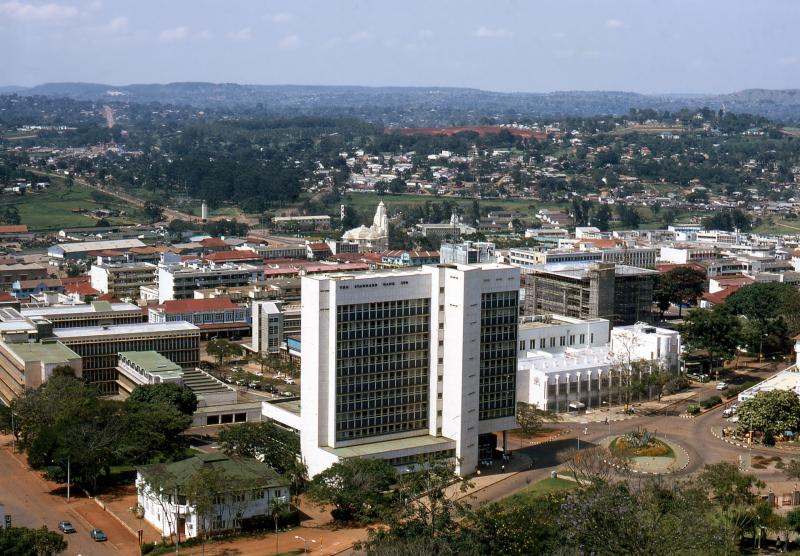Changing mindsets in Kampala, Uganda

While Africa remains the least urbanized continent, it has the fastest rates of urbanization in the world. In Uganda, levels of urbanization in towns across the country remain relatively low, but in the capital Kampala, the population is increasing by an average of 6 per cent each year. While the resident population is only 1.5 million, it swells to 4.5 million during daytime hours as people enter the city for employment.
‘We have a steady influx of people coming to the city from rural areas and are hosting 100,000 refugees from Sudan, Somalia and DRC,’ says Samuel Sserunkuma, acting executive director of the Kampala Capital City Authority - KCCA. ‘We don’t have sufficient services or infrastructure such as schools, health centres or toilet facilities to meet the demands of this growing population’.
Encroachment on the city’s wetlands and expansion of informal slum settlements has created urban planning challenges for the city authorities. Such communities are exposed to multiple hazards including floods, fires and landslides. The associated economic losses amount to USD 30 million each year and are projected to exceed USD 100 million by 2040.
Consolate Kiyingi works as a risk manager with KCCA. She has been leading the ‘Making Cities Sustainable and Resilient’ project which aims to reduce disaster risk and build resilience amongst the city’s population. Funded by the European Commission, with technical support provided by the United Nations Office for Disaster Risk Reduction (UNDRR), the project brought together the city authorities, the private sector, NGO’s and civil society, to create a new disaster risk reduction action plan for Kampala.
The process started with mapping risks and levels of vulnerability in the city. Flooding and waterlogging during the rainy season emerged as the foremost hazard facing Kampala’s residents, followed by disease outbreaks and epidemics.
‘To combat flooding, we are investing a lot in infrastructure works such as upgrading and improving roads and drainage channels’, explains Consolate. ‘In our new DRR plan we will also be working on mindset change. A lot of the flooding in the city is due to blocked drains caused by poor waste management at the community level. We are taking action - engaging and educating communities, and involving them in clean-up campaigns.’
Jude Biansi Ziwa works with KCCA’s directorate of public health and environment. One of his priorities under the DRR plan is to ensure that toilets in the city meet minimum standards and prevent the spread of communicable and waterborne diseases linked to poor sanitation.
‘We found that 40% of pit latrines were being abandoned because people had no emptying mechanism. We are looking at the whole chain for building and maintaining a toilet, treating the waste and turning it into a useful end product’, explains Jude.
Efforts are being scaled up to improve community level systems for waste management. KCCA is incentivising private contractors by creating systems that drive demand. Householders can connect with a competitively priced service provider when their latrine needs emptying through a call centre run by KCCA using a toll-free number.
During heavy rains, floodwaters cause latrines to overflow into the surrounding community resulting in outbreaks of cholera and typhoid. Behavioural change communication around good sanitation practises and what prevention steps are required, particularly in low-income communities and schools, is prominent in Kampala’s DRR plan.
The municipality is also driving innovation at the community level.
‘We are introducing bio-toilets in schools that use less water,’ explains Jude. ‘Some schools can’t afford the firewood to cook school meals and this affects children’s nutrition. These toilets not only conserve water, they produce biogas which can be used for cooking. We know that children are change agents, we want them to take these ideas home and encourage their parents to adopt them’.
Plans are also in place to reduce levels of plastic waste in the capital. KCCA is working on plastics collection and recycling schemes with partners such as Coca-Cola who buy back plastics collected by communities.
Kampala’s DRR action plan will be harmonized with the city’s climate change strategy into one plan that aims to transform Kampala into a vibrant and sustainable city that can adapt to the impacts of changing weather patterns. The city’s geography, comprised of hills and valleys means that rains received on high ground often result in flash floods in low-lying areas. Maintaining the city’s vegetation helps reduce rainwater run-off and KCCA is pursuing a forward-looking landscaping and greening agenda that protects the cities green spaces and encourages property owners to plant more trees.
‘When we look at developments, we don’t just look at the built areas but also the unbuilt areas,’ explains Isaac Mogombole, from KCCA’s directorate of physical planning. ‘We used to clash with engineers when they were building road or drains. Now when a road is built, they factor in the lighting, trees, grass and walkways not just the road and it’s drainage.’
One of the challenges for the city-planners has been the growth of informal settlements and the lack of detailed neighbourhood plans.
‘We’ve had issues with poor data management and haven’t been systematic about maintaining it in a centralised place,’ explains Consolate Kiyingi. ‘Information has been kept in silos so if there’s a disease outbreak the public health department will have the information. If there’s flooding it will be under engineering.’
KCCA is now planning to use the country’s national data management system ‘Desinventar’, applying it at the city level to consolidate and streamline data.
‘From the moment a disaster happens we will have a clear picture of the number of people affected, we can disaggregate that data according to gender and will also be able to have a picture of economic losses.’
For Consolate, the Making Cities Sustainable and Resilient project has been a wake-up call. ‘We are now working on every institutional level to develop our governance, overhaul our systems and develop mechanisms to reduce disaster losses’.
